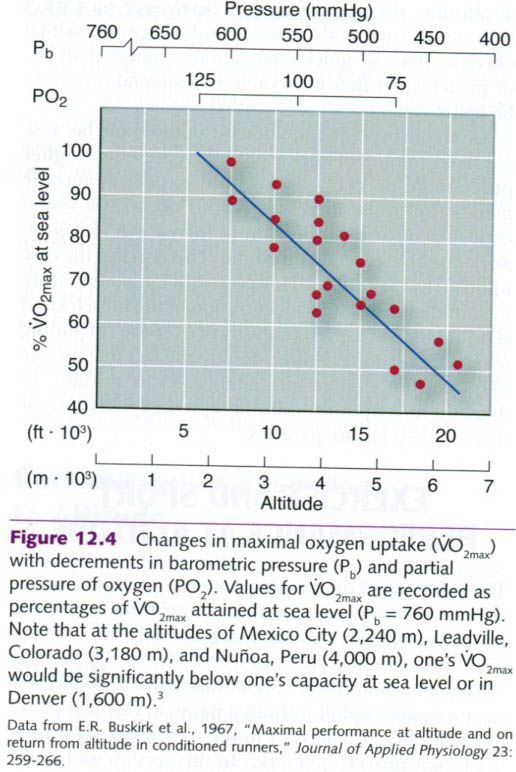Maximal oxygen uptake and endurance activity
Maximal oxygen uptake decreases as altitude
increases(picture below). VO2max decreases little until the
atmospheric PO2 drops below 131mmHg. This generally occurs at an
altitude of 1,500 to 1,600m(approximately 5,000ft) – about the elevation of Denver , Colorado
As shown in the figure below, men climbing
Mount Everest in a 1981 expedition experienced a change in VO2max
from about 62 ml x kg-1 x min-1 at sea level to only
about 15 ml x kg-1 x min-1 near the montain’s peak.
Because resting oxygen requirements are about 3.5 ml x kg-1 x min-1,
without supplemental oxygen these men had little capacity for physical effort
at this elevation. A study by Pugh and coworkers showed that men with VO2max
values of 50 ml x kg-1 x min-1 at sea level would be
unable to exercise, or even to move, near the peak of Mount Everest because
their VO2max values at that altitude would decrease to 5 ml x kg-1
x min-1. Thus, most normal people with sea-level VO2max
values below 50 ml x kg-1 x min-1 would be not be able to
survive without supplemental oxygen at the summit of Mount Everest because
their VO2max values at such an altitude would be too low to sustain
their body tissues. Enough oxygen would be consumed to barely meet their
resting requirements.
Obviously, activities of long duration that place
considerable demands on oxygen transport and uptake to the tissues are the most
severely affected by the hypoxic conditions at altitude. At the summit of Mount Everest , VO2max is reduced to 10% to 25%
of its sea-level value. This severely limits the body’s exercise capacity.
Because VO2max is reduced by a certain percentage, individuals with
larger aerobic capacities can perform a standard work task with less perceived
effort and with less cardiovascular and respiratory stress at altitude than
those with a lower VO2max. This may explain how Messner and Habeler
were able to reach the summit of Everest without supplemental oxygen in 1978 –
they obviously possessed high sea-level VO2max values.
Anaerobic sprinting, jumping, and throwing activities
Whereas endurance events are impaired at
altitude, anaerobic sprint activities that last less than a minute(such as 100m
to 400m sprints) are generally not impaired by moderate altitude and can
sometimes be improved. Such activities place minimal demands on the oxygen
transport system and aerobic metabolism. Instead, most of the energy is
provided through the adenosine triphosphate(ATP) and glycolitic systems.
In addition, the thinner air at altitude
provides less aerodynamic resistance to athletes’ movements. At the 1968
Olympic Games, for example, the thinner air of Mexico City Mexico City











0 коментара:
Постави коментар